pesto
Pesto and I had a bit of a rough start. I first tried it on a pizza and I didn’t like it. We were sitting in a North End pizzeria in Boston, on a middle-school trip, and a girl I thought was amazingly cool and knew all things worth knowing, ordered a pizza with pesto. I had no idea what it was, and was too shy to ask, not wanting to seem even less cool than I already was.
A few minutes later it arrived, golden and bubbling, studded with green, oily blobs of pesto. It was potent and garlicky-smelling, but it wasn’t calling out to me. My suspicions proved right – aside from not looking good, it also wasn’t very good. It tasted stale, rancid, and too oily. Looking back, I realize it wasn’t very good pesto, but back then I just thought pesto wasn’t for me. I didn’t know the difference between good and bad.
In retrospect, I can tell you that what probably happened in this non-descript, very mediocre pizza parlor was this: a jar of premade pesto (made when? and by whom?) was opened, spooned onto a chewy pizza and served to hungry middle school kids. We ate it because that’s what middle school kids do – they eat pizza. Without counting calories or slices, without blotting the oil – teenagers are pizza fiends. We were no different. But I do remember the experience well enough because it would be years before I would try pesto again. My goodness – how many years have I lost?
I do remember having homemade pesto at friends’ homes – made by their mothers, grandmothers. It was indescribable. Intensely-garlicky, nutty, aromatic and textured – pesto was made in small batches, always fresh, and always by hand. I know a mezzaluna was involved. I also remember overhearing that one should never ever make it in a food processor. Because what you get in return is a paste – and pesto is anything but that. Still, it didn’t sink in until a few years later, which brings us to roughly today.
This year, for no apparent reason save for my cravings, I’ve been on a ravenous pesto kick. I have been trying it in restaurants, experimenting with ingredients and proportions, dabbling with various techniques. I’ve made it by hand, by food processor; I’ve purchased it at high-end purveyors. Something, somehow, was still missing.
One night, while trying to figure out what to make for dinner while Andrew was en route back from work, I decided to google “pesto technique”. I had a bunch of basil lying around and I also just picked up some fresh pine nuts, Parmesan, and fresh ricotta. Did you know if you enter “pesto technique” in the search, the first result that pops up is Heidi’s instructions over at 101 Cookbooks? Heidi knows her pesto, and not only that – she knows how to make your pesto taste just like a pesto an Italian grandmother would make.
Heidi emphasizes chopping everything by hand and, and this is important, not blending everything together. A pesto should not look or taste like a paste. It should have separate flecks of flavor, little bursts, surprises – when you taste it. Apparently, if we’re going to get really authentic here, and we should – you should make pesto only with young basil leaves, which in the US are easy to find in the spring, but during the majority of the year, you’ll most likely be out of luck. That is unless you grow your own basil.
While I didn’t have a mezzaluna on hand, I followed Heidi’s instructions to a tee – and the results were spectacular. The beauty of making your own pesto is that the freshness and brightness of flavors can never be recreated from a premade version. Yes, chopping everything finely by hand might take you a little bit of time. It is certainly more time-consuming than whirring everything together in a food processor. But the results will also differ. Your hand-made pesto will be full of surprises both in flavor and texture while your machine-made one, while it will certainly be tasty, will suffer on the texture aspect.
A mezzaluna is on my list of next things to buy for the kitchen, and I plan on growing my own basil on the windowsill this spring, so I’m excited about making pesto with the young leaves. In the meantime, my local grocer’s bunches of lush, verdant basil will just have to do – plus, I keep hearing, spring is just around the corner.
Pesto
Adapted from 101 Cookbooks
While you can certainly place all the ingredients in the food processor and have pesto ready in 2 minutes, I encourage you to try to do this by hand. I used a large chef’s knife because I’m still lacking a mezzaluna. I won’t lie to you, you’ll be chopping for solid 15 minutes at least (which might seem like a long time to chop), but I guarantee you that you’ll be blown away by the difference in texture. The flavor, too, will be brighter – the garlic will be garlicky-er; the basil – more basil-y; the pine nuts – a bit nuttier. It’s good, so good in fact, that you might make it several nights and a row and your boyfriend (or girlfriend) won’t even complain that you’ve been eating pasta for several days on. And here’s a bonus, if you live in a tiny apartment with an even tinier kitchen and almost no counter space – this recipe should be exciting. With no food processor necessary, you now have an additional dish to whip up for yourself or when you have company. With a dollop of fresh ricotta, this humble meal can be, easily, turned into a feast!
Ingredients:
1 large bunch of basil, leaves only, washed and dried
3 medium cloves of garlic
one small handful of raw pine nuts
roughly 3/4 cup freshly grated, loosely packed Parmesan
A few tablespoons of extra-virgin olive oil
Preparation:
1. Start chopping the garlic along with about 1/3 of the basil leaves. Once this is loosely chopped add more basil, chop some more, add the rest of the basil, chop some more. Continue to scrape and chop, gather and chop. At this point the basil and garlic should be a very fine mince. Add about half the pine nuts, chop. Add the rest of the pine nuts, chop. Add half of the Parmesan, chop. In the end you want a chop so fine that you can press all the ingredients into a basil “cake” – i should be a tightly packed square. Transfer the pesto “cake” to a small bowl (not much bigger than the cake), add the rest of the Parmesan, and stir well to combine. Cover with a bit of olive oil, it doesn’t take much, just a few tablespoons.
2. You can set this aside or place it in the refrigerator until you are ready to use it. Just before serving give the pesto a quick stir to incorporate some of the oil into the basil.
Makes about 1 cup.
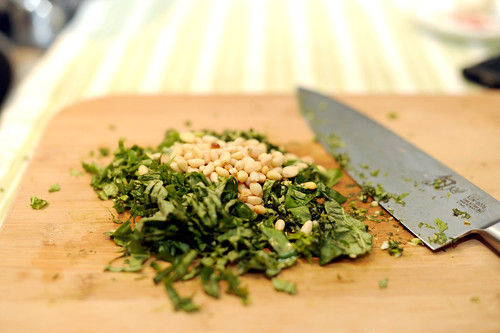
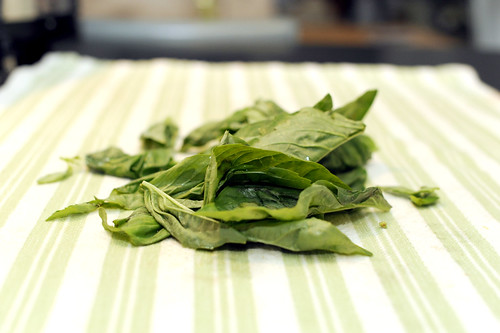
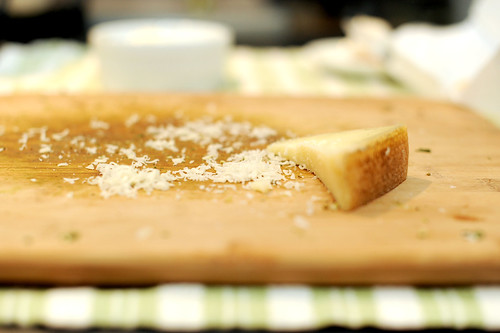
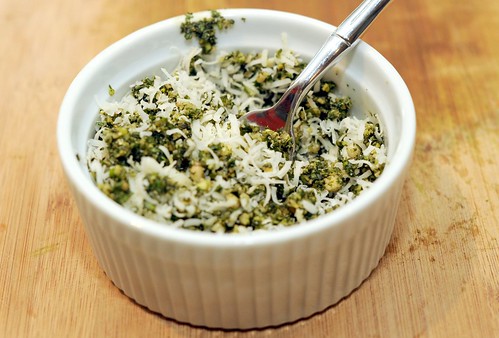
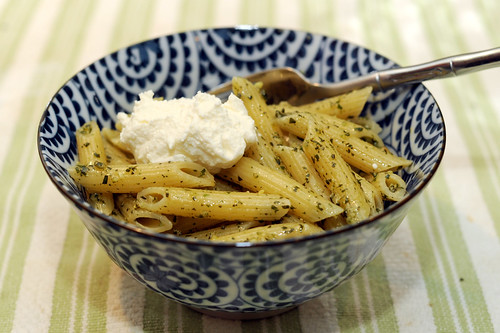
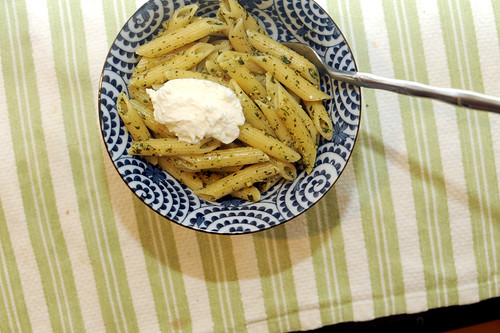
eclecticgourmet
I was hoping for a shortcut but I guess the best results come w/ a little patience and elbow grease! will def. try this out, thank you!
Gail
Your pesto history mirrors my own. I always HATED it….too gummy, too pasty, too garlicky…just too too!!!
Until I ate a pesto genovese at Barbuto here in the W. Village. NOW I get it…exactly as you’ve described. Flecks of aromatic basil, not gloppy lumps of the stuff.
I’m a convert. And, I’m going to make it by hand, too.
Brian @ A Thought For Food
This hand-chopped pesto is brilliant! I’m such a fan of pesto (I’ve used everything from mint to beet greens) and have always used my food processor… but I LOVE the idea of getting this wonderful consistency.
ilya
Awesome. I can’t pass a bunch of basil in a store, and it usually ends up in pesto (with different nuts), but I never tried to do the chopping by hand. Next time I will :).
Tweets that mention pesto « Sassy Radish -- Topsy.com
[…] This post was mentioned on Twitter by sassyradish, sassyradish. sassyradish said: {NEW POST} pesto http://goo.gl/fb/BG9hG […]
Marguerite
Adding the zest from an orange and a lemon is my favorite way to perk up pesto when I’m growing tired of the traditional recipe. I have always been a food processor pesto maker myself, but you have inspired me to try something new!
Radish
Gail – I’m glad someone understands my former plight! And everyone – I’m so excited you’re going to try a new way of making pesto. I think you’ll be pleasantly surprised!
Errin
I had to google what a mezzaluna is…and now I want one too. Thanks for insight into the world of pesto recipe testing and perfecting :)
Jennie
Pesto is also one of those things that varies by region. My aunt always made it “by hand”, yet the first one I ever liked was prepared by a friend husband’s from Italy. He’s from Turin, all the way up north, and prefers making a creamy pesto by adding pats of butter. I guess it really does make everything better.
Radish
Jennie – that’s right, northern pesto, much like a lot of Northern Italian cooking, uses butter! I love the Northern stuff too. Yum.
Dana
Pesto using butter sounds like an interesting idea. :)
You are so right though, home made, single batches and jarred paste are so far apart that it’s hard to call both of them pesto.
Allison
This post has got me excited about pesto again! I have been disappointed the last few times I’ve made it at home (in a food processor), and maybe this is the difference I’m looking for!
Caitlin
Looks beautiful and I’m not doubting it tastes the same. Thanks for posting this, I was convinced a blender was the route to take, but I’ve learned my lesson too. Thanks!
Rachel
I too hated pesto for years after a first bad experience! I’m so excited to get to try this (pesto is made, pasta is cooking). I’ve never considered making pesto before because I don’t own a food processor, and this was super easy, so thank you!
Chihiro
Thank you for the redemption. My homemade pesto has always tasted amazingly like nothing. I don’t have a mezzaluna either but I hope I can try this if I ever find good basil. :)
Molly
I am a pesto fanatic. I grow my own basil and make it in a blender. I have never been happy with pesto in restaurants or – god forbid – from a jar, because freshness and single batches really matter. I will reluctantly try making it by hand ( because I fear I’ll never go back to the blender) though I have no doubt it will be worth it. I do like to lightly toast my pinenuts to bring out the nuttiness – I’ll have to try both ways now to compare. The addition of ricotta is genius.
marcella
Your sauce is interesting in its different sparks of flavours, but, forgive me, it’s quite different from pesto.
As some Italian commenters on Heidi’s post said, pesto is made by *pounding* (=pestare) ingredients together in a mortar, with a pestle. However time consuming it sounds (and is), this is how *true* pesto should be made. And when you pound away, I can tell you you do end up with a paste, so its authentic texture has indeed the ingredients well mixed into each other.
Chopping is a no-no, as repeated cutting down with a kinfe blade will hurt the leaves, make their juice run and sink into your cutting board and the result will be quite bitter-tasting (just imagine that when we add fresh basil to a tomato sauce or a salad, we tear the leaves up with our fingers, and would never consider even using scissors). Also, basil gets oxydized very quickly, so when chopped it turns black and bitter in no time – imagine chopping away for 30 minutes…
Food processor is a good compromise, especially if you begin by processing the harder ingredients by themselves and add the basil at the very end, with the oil, giving the whole thing a quick whizz just to blend it together. In a food processor bowl (just like in a mortar) you don’t lose the basil juice and the chopping is so quick that it won’t have the time to turn black.
(may I add that this is the way most people in Italy make pesto nowadays.)
Excuse me for the rant :) But, as someone said, Italians do make a fuss about food :)
Radish
Marcella – can you recommend a good mortar and pestle that actually might do the trick? I’ll give it a go. That, actually, makes a good deal of sense and thank you so much for the “rant”. It’s actually more helpful and educational than anything, which is EXACTLY what the comment section here is for – so that we can all learn. I’d love to give another method a try. So if you have a recommendation, please let me (and everyone else) know! Thanks!
marcella
Radish – thank you :)
nothing is more down to earth than pestle and mortar :)
The mortar should be heavy, ideally in marble. Not too large, as I feel it is easier to use if the ingredients don’t move around too freely. Pestles are usually made from turned wood, even if wooden tools are a pet-peeves of mine. Just choose one that feels good in your hand.
As you are so patient, I’d like to add that the most important thing about pesto is basil itself. The wrong kind – too old, too strong in flavour, or even the wrong variety – will spoil your pesto, no matter how you make it!
Have fun pounding – it can be very liberating, especially after a stressful working day ;)
Kathy
I am looking forward to hearing about how the “chopped” version compares to the mortar and pestle “bashed” version compares
Tamra
I like to make enormous batches of pesto in the summer with basil from our garden and freeze it in 1/2 cup containers. It freezes (and thaws) remarkably well, and it can be such a lifesaver having pesto in the freezer and pasta in the cupboard.
Radish
Tamra – that’s great to know – thanks for sharing the tip!
The Perfect Pesto from Sassy Radish - Martha's Circle
[…] and not blending everything together. So get your garlic, basil, and pine nuts ready — Here's the recipe and a lesson on making the perfect pesto to add to tonight's pizza or […]
anna
Pesto is one of my very favorite things! I remember when I was in high school and my mom and I discovered it, we made it all the time! And now I’m craving it ;)
a frog in the cottage
I LOVE PESTO !! Just perfect !!